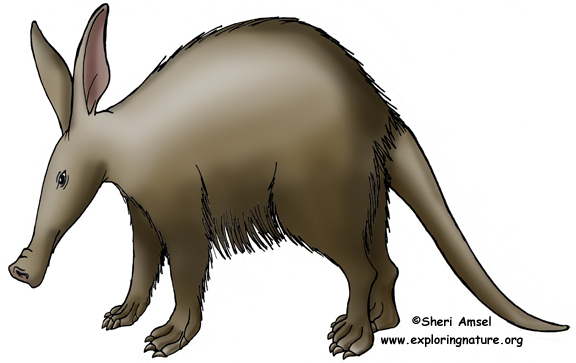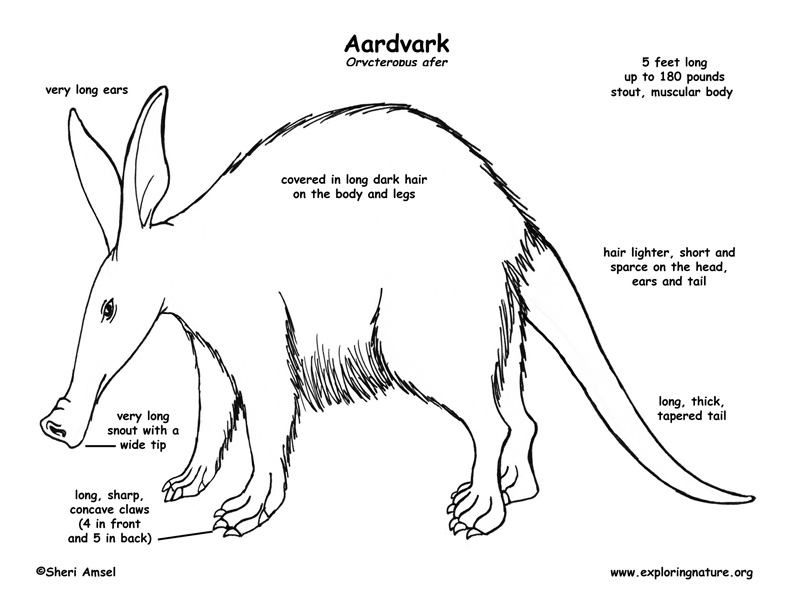

Aardvarks are found in grassland regions of Africa – south of the Sahara Desert (sub-Saharan).
Aardvarks live on the grasslands where ants and termites build their giant mounds.
Aardvarks can reach 5 feet long and weigh up to 180 pounds (females are smaller). They have a stout, muscular body that is arched in shape. They have short legs and a long, thick tail that comes to a point at the end (cone-shaped). Their long, sharp, concave claws which help make them powerful diggers. Their digging skill is boosted by their longer back legs which lets them push in as they dig and kick the dirt out the back. They have a very long snout with a wide tip for increasing their excellent sense of smell. They have no front teeth (incisors) or canines, just grinding molars in the back. They draw in ants with their foot-long, sticky tongue and grind them with their molars briefly (if at all) before swallowing. They also have very long ears – not unlike those of a jackrabbit – that are excellent for picking up sound. They are covered in long, dark hair on the body and legs. The head, ears and tail are lighter in color and the hair is short and sparse. As they age, they lose their long body hair.
Aardvarks live alone (solitary) except for when they mate or raising young. They are territorial and only a female offspring may stay with its mother beyond 6 months (until she breed again). They are active at night (nocturnal) and may travel many miles to find ants. They then spend the day sleeping in underground burrows. They are built for digging with clawed feet and powerful legs and when threatened can dig underground in seconds to escape predators. They make quick work of termite mounds, digging in and inserting their long, sticky tongue to draw out the insects. Despite their digging power they do not totally destroy the nests of their prey so that they can rebuild (which allows for potential future feedings). Aardvarks also dig dens and burrows in which to sleep during the day and raise young. When they move on to new places in search of food, the burrows they leave behind are important shelters for other African animals. Despite their stout size and hunched shape they are quick and agile. They will exit their dens at a dead run followed by a series of jumps and and spins. This strange tactic is probably meant to confuse potential predators that might be waiting outside their dens.
They dig out ants and termites from their large mounds and underground nests.
They are killed by lions and hyenas and man.
Females are pregnant for 7-8 months (gestation). They usually have one baby each year (sometimes 2) that is born naked and weigh about 4 pounds. They give birth in their burrow and the baby nurses for 3 months before it is old enough to start eating insects. At 6 months old they are old enough to go our on their own though female offspring often stay with the mother longer.
Aardvarks can live up to 18 years in the wild. They are listed as least concern on the IUCN Red List, though have been eliminated in developed areas or where farmers or ranchers have poisoned the termite and ant mounds.
Domain: Eukaryota
Kingdon: Animalia
Phylum: Chordata
Class: Mammalia
Superorder: Afrotheria
Order: Tubulidentata
Family: Orycteropodidae
Genus: Orycteropus
Species: O. afer
When you research information you must cite the reference. Citing for websites is different from citing from books, magazines and periodicals. The style of citing shown here is from the MLA Style Citations (Modern Language Association).
When citing a WEBSITE the general format is as follows.
Author Last Name, First Name(s). "Title: Subtitle of Part of Web Page, if appropriate." Title: Subtitle: Section of Page if appropriate. Sponsoring/Publishing Agency, If Given. Additional significant descriptive information. Date of Electronic Publication or other Date, such as Last Updated. Day Month Year of access < URL >.
Amsel, Sheri. "Aardvark" Exploring Nature Educational Resource ©2005-2024. December 13, 2024
< http://www.exploringnature.org/db/view/496 >

